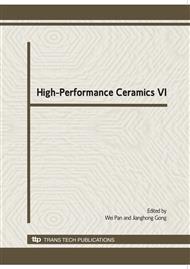p.48
p.50
p.54
p.57
p.61
p.64
p.66
p.69
p.72
Defects Analysis of Large Size Silicon Nitride Balls Sintered by Gas Pressure Sintering
Abstract:
The sections of Φ55mm silicon nitride balls, sintered by gas pressure sintering were analyzed. The results show that temperature gradient during of the sintering process from the surface to the core of large size silicon nitride balls occurred because of the lower thermal conductivity of Si3N4. With the diameter increasing, the temperature gradient was more visible. The impurity of raw materials, such as free Si, free C and other metal oxides, like the SiO2 could produce gas, such as SiO, CO and so on, during the sintering process through the thermodynamic analysis. The producing gas exhausted more difficultly with the diameter of silicon nitride balls increasing. These factors were the most important to the defects of large size silicon nitride balls during the sintering process and made cracks and crescent on the surface of balls.
Info:
Periodical:
Pages:
61-63
Citation:
Online since:
March 2010
Authors:
Keywords:
Price:
Сopyright:
© 2010 Trans Tech Publications Ltd. All Rights Reserved
Share:
Citation:


